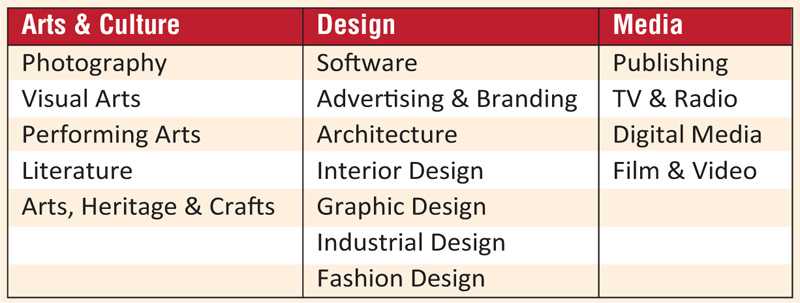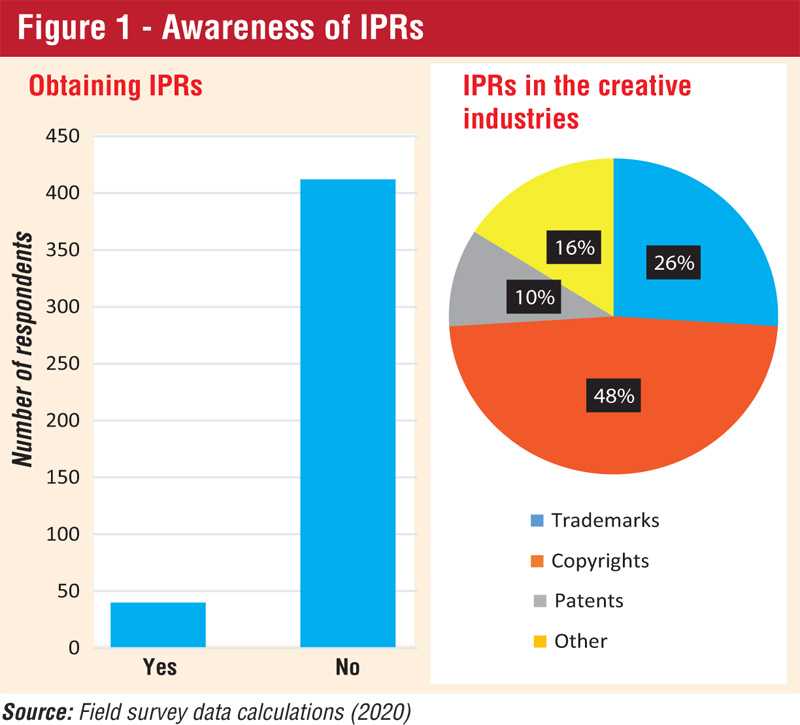Monday Dec 01, 2025
Monday Dec 01, 2025
Tuesday, 27 April 2021 00:00 - - {{hitsCtrl.values.hits}}

 By Dilani Hirimuthugodage
By Dilani Hirimuthugodage
It is said that oil was the primary fuel of the 20th century economy while creativity is the fuel of the 21st century.
Creative industries encompass a broad range of activities such as arts, craft, music, design and media which have their origin in individual creativity, skill and talent, and have a potential for wealth and job creation through the generation and exploitation of intellectual property. Creative industries are vital to many economies, accounting for 7% of the world’s GDP and growing at an annual rate of 8.7% according to the latest available data.
The World Intellectual Property Rights Organization (WIPO) marks IP day under specific themes, and this year, it focuses on creativity in Small and Medium Enterprises (SMEs) in bringing novel ideas to the market. Intellectual Property Rights (IPRs) including copyrights, trademarks, Geographical Indications (GI), patents, and sui generis systems are important in protecting and fostering creativity.
This article highlights the importance of IPRs for Sri Lanka’s creative industries and offers strategies to build stronger, more competitive and resilient businesses.
 Creative industries in Sri Lanka
Creative industries in Sri Lanka
Sri Lanka’s creative sector can be broadly divided into three categories: arts and culture, design, and media. A study by the Institute of Policy Studies of Sri Lanka (IPS) commissioned by the British Council, Sri Lanka identified 16 subsectors as creative industries (see table).
According to the available data, Sri Lanka’s creative industry has shown a growth of 95% between 2010 to 2014, rising from $ 433.6 million to $ 845.4 million. An approximate estimate of the GDP share of creative goods and services exports in 2014 was nearly 1.1%.
The IPS survey, which sought to capture the current size and scale of the creative industry sector in Sri Lanka, found that only 4.6% of respondents were export-oriented and the balance produced for local consumption. Thus, the 1.1% GDP share is an underestimate, as it only accounts for the exports of creative goods and services.
The IPS survey also found that the number of employees in the sector make-up approximately 3% of the country’s total labour force. Approximately 36% of creative workers are female and 67% of workers in the sector are between the ages of 24 and 55 years, while 71% of workers are in the private sector and the rest is in Government and semi-Government sectors. Self-employment is high in this sector, with 40% of the workforce identifying themselves as ‘self-employed’. As is the case globally, in Sri Lanka too, the sector consisted mostly of SMEs and sole traders with only a few large businesses.
Most importantly, the creative industries depend on the talents of individuals and the generation of intellectual property. Thus, several IPRs are relevant to the sector. For example, copyrights for literature, music, visual arts, digital creative work, trademarks for advertising and branding, GI for location-specific creativities, and patents for gaming and digital designs. Therefore, IPRs play a major role in driving this sector. Further, IP enforcement is important to protect the creator and/or investors to provide them with incentives to invest and further develop the sector.
Creative sector and IPRs in Sri Lanka
The awareness of IPRs among the survey respondents in the above-mentioned IPS study was poor. Only 8.8% had obtained any form of IP protection, out of which 48% had copyrights, 10% had patents, 26% had trademarks and 16% had others. Copyrights and trademarks were taken up in each sector whereas patents were only adopted in a few subsectors such as visual/performing arts, crafts, advertising, etc. (Figure 1).
However, most of the survey and Focus Group Discussion (FGD) participants were not aware of IPRs relating to their businesses and the following quotes highlight this:
“We didn’t take it seriously. We know there are certain rules but people don’t respect them. If you work for a big brand company under contract then they can keep our ideas/products in their companies. And also, they request us to sign non-disclosure agreements with these companies” – FGD participant.
“In gaming, we have to take IP rights for gaming characters. For this, it will take nearly two-three months to obtain and it is very time-consuming” – FGD participant.
“As designers and creators, we don’t know our IPRs” – FGD participant.
Way forward
IPRs are relevant to the creative industry as it relies on the use of intellectual production to create its goods and services. Following are a few suggestions to enhance the effective utilisation of IPRs for the development of the creative sector: Firstly, it is important to enhance knowledge on access to IPRs in the creative industry sector through awareness programmes at the grassroots levels especially in the craft, music, dance and design sectors. Industry professional associations should take the lead in this regard.
Secondly, many traditional creative industry sectors such as craft, performing arts, and visual arts are location-specific such as Ambalangoda masks, Dumbara mats, and Weweldeniya cane products. Thus, products can use GI to indicate that the goods have a special quality, character or reputation because they originate from a specific place. This will help to protect their rights, increase product value and better visibility. As such, the National Intellectual Property Office (NIPO) must speed up the process of identifying and obtaining GIs for selected sectors while also expanding links with WIPO to protect traditional creative industries.
Thirdly, at the national level, it is important to adopt a sui generis (a unique system) legal framework for protecting traditional knowledge and cultural expressions, which are ultimately the foundation from which Sri Lanka creates its unique designs.
Fourth, laws need to be updated as the existing legal framework does not cater to developments in modern technology. NIPO should also improve its efficiency and capacity to cater to modern creativities especially for IT and design sectors.
Finally, Sri Lanka must modernise its IP system, incentivise grassroots innovation and promote homegrown creativity to fuel a culture of creativity.

[This blog is based on an IPS study, commissioned by the British Council, Sri Lanka on Creative and Cultural Industries in Sri Lanka (2020).]
[Dilani Hirimuthugodage is a Research Economist working on Environment, Natural Resources and Agriculture Policy at IPS. Her research interests include agriculture economics, food security, intellectual property rights and innovations. She holds a Masters in Economics (with Distinction) from the University of Colombo. She is part-qualified in Charted Institute of Management (CIMA-UK). Talk to Dilani: [email protected].]
(Link to Original Blog: https://www.ips.lk/talkingeconomics/2021/04/25/creating-a-culture-of-creativity-the-importance-of-intellectual-property-rights/)